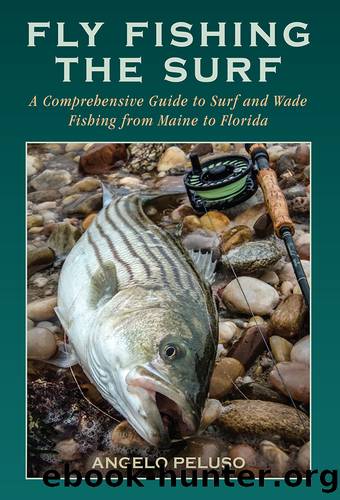Fly Fishing the Surf by Angelo Peluso

Author:Angelo Peluso
Language: eng
Format: epub
Publisher: Skyhorse Publishing
Published: 2013-01-01T00:00:00+00:00
Tarpon. (Photo credit: Nick Angelo)
Consistently catching tarpon on a fly from the beach is a formidable challenge but it can be done. Success at this game requires a resolute will, patience, and unyielding determination; success is often measured in small victories. The challenge is to place the fly in the path of oncoming fish, often moving at high rates of speed across open sand and grass flats. The fly must be presented at a correct angle so that it crosses the path of the tarpon in a natural way. This involves leading fish with the cast, much as a quarterback leads a receiver. Despite their size, tarpon are surprisingly wary of anythingâincluding fliesâthat comes at them from an unnatural direction. Once the fly is cast and allowed to sink to the level of the fish, long, steady retrieves should get it to intersect the fishâs route and capture its attention. Should the fish react to the fly in a positive way, chalk that up as a minor victory.
When a big tarpon tracks a fly in thin water it is tough to maintain oneâs composure while watching the drama unfold! I can vouch for that from personal experience. Buck fever pales in comparison to this deal! But the fly must continue moving along steadily and in a way so as to maintain the âbeastâsâ interest. Sometimes, tarpon will nose the fly or bump it. This is when oneâs self control needs be at its peak. Often, a break in the retrieve with either a slight pause or some form of subtle seductionâlike jiggling the fly with the rod tipâcan excite and stimulate the fish. The goal at this stage of the presentation is to make the fly look aliveâto get the tarpon to want to eat it. If the fish actually does inhale the fly, consider that another minor victory, or perhaps even a small miracle!
When a tarpon does eat, one of two things will happen. The strike will either be an unmistakable, bone-jarring smash, or a take so subtle you will think a small seatrout may have mouthed the fly. This latter strike is where it gets tricky. The natural inclination is to lift the rod. That is a big mistake! Iâve been there, too! At this point in the game, one needs to keep the fly in motion, even if you see the take and the accompanying flash of a turning fish. The key is letting the line go completely tight, as if you were hung up on a log. Once that happens, a few strip strikes just might seal the deal. If the fly angler makes it this far, congratulations on a job well done. But the mission is far from accomplished, for this is when the difficult work begins in fighting the fish and getting it to the beach.
Download
This site does not store any files on its server. We only index and link to content provided by other sites. Please contact the content providers to delete copyright contents if any and email us, we'll remove relevant links or contents immediately.
Sapiens: A Brief History of Humankind by Yuval Noah Harari(14311)
The Tidewater Tales by John Barth(12625)
Mastermind: How to Think Like Sherlock Holmes by Maria Konnikova(7274)
Do No Harm Stories of Life, Death and Brain Surgery by Henry Marsh(6904)
The Thirst by Nesbo Jo(6874)
Why We Sleep: Unlocking the Power of Sleep and Dreams by Matthew Walker(6649)
Life 3.0: Being Human in the Age of Artificial Intelligence by Tegmark Max(5506)
Sapiens by Yuval Noah Harari(5320)
The Longevity Diet by Valter Longo(5038)
The Body: A Guide for Occupants by Bill Bryson(5024)
The Rules Do Not Apply by Ariel Levy(4905)
The Immortal Life of Henrietta Lacks by Rebecca Skloot(4546)
Animal Frequency by Melissa Alvarez(4424)
Why We Sleep by Matthew Walker(4392)
The Hacking of the American Mind by Robert H. Lustig(4334)
Yoga Anatomy by Kaminoff Leslie(4331)
All Creatures Great and Small by James Herriot(4266)
Double Down (Diary of a Wimpy Kid Book 11) by Jeff Kinney(4238)
Embedded Programming with Modern C++ Cookbook by Igor Viarheichyk(4135)
